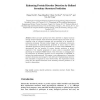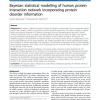6 search results - page 1 / 2 » Identification of Intrinsically Unstructured Regions in Prot... |
BIOCOMP
2006
13 years 6 months ago
2006
Most proteins function only when folded into a particular 3D configuration. Recently, a class of proteins has been discovered that do not fold into any particular configuration; t...
BIRD
2007
Springer
13 years 11 months ago
2007
Springer
More and more proteins have been observed to display functions through intrinsic disorder. Such structurally flexible regions are shown to play important roles in biological proces...
BMCBI
2010
13 years 5 months ago
2010
Background: We present a statistical method of analysis of biological networks based on the exponential random graph model, namely p2-model, as opposed to previous descriptive app...
BMCBI
2007
13 years 5 months ago
2007
Background: Homology is a key concept in both evolutionary biology and genomics. Detection of homology is crucial in fields like the functional annotation of protein sequences and...
BMCBI
2010
13 years 5 months ago
2010
Background: Tissue MicroArray technology aims to perform immunohistochemical staining on hundreds of different tissue samples simultaneously. It allows faster analysis, considerab...


